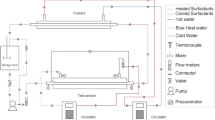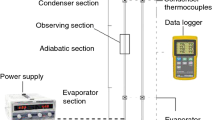Abstract
It is well known that a small amount of chemicals such as water-soluble polymers or surfactants dramatically suppresses turbulence when they are added to liquid flow at large Reynolds number. In the last two decades, the application of surfactants to heat transportation systems such as district heating and cooling systems has attracted much interest among researchers. It has been revealed that 70% of the pum** power used to drive hot water in primary pipelines or district heating systems was saved by adding only a few hundred ppm of surfactant into the circulating water. The technological achievement requires a new design strategy for pipeline networks and heat exchangers to handle the drag reducing liquid flow. In the case of a Newtonian fluid such as water or air, the knowledge for designing fluid systems has been accumulated and the accuracy of numerical prediction is sufficient. On the other hand, the design system for surfactant solutions is not mature because drag-reducing flow phenomena are much more complicated than for Newtonian flow, for example, the friction factor for a surfactant solution depends not only on Reynolds number but also pipe diameter. In order to provide a design strategy for heat transportation systems using surfactant additives, we are now carrying out both experimental and numerical studies for surfactant solutions. In this lecture, experimental and numerical studies on the turbulence structure in drag reducing flow will be introduced. The result of an application study relating to the air conditioning system will be also shown.
Access this chapter
Tax calculation will be finalised at checkout
Purchases are for personal use only
Preview
Unable to display preview. Download preview PDF.
Similar content being viewed by others
References
Toms B.A. Some observation on the flow of linear polymer solutions through straight tubes at large Reynolds numbers. In: Proc. 1st Int. Cong. Rheol., North Holland, Amsterdam, 1948;2:135–141.
Lumley J.L. Drag reduction by additives. Ann. Rev. Fluid Mech., 1969; 1: 367–384
Lumley J.L. Drag reduction in turbulent flow by polymer additives. J. Polymer Sci., 1973; 7: 63–290
De Gennes P.G. Introduction to Polymer Dynamics. Cambridge. Cambridge University Press. 1990.
Kawaguchi Y., Segawa T., Feng Z.P., Li P.W. Experimental study on drag reducing channel flow with surfactant additives — Spatial structure of turbulence investigated by PIV system. International Journal of Heat and Fluid Flow, 2002; 23–5: 700–709
Li F-Ch., Kawaguchi Y., Segawa T., Hishida K. Reynolds-number dependence of turbulence structures in a drag-reducing surfactant solution channel flow investigated by PIV. Physics of Fluids, 2005; 17 075104: 1–13
Li F.-Ch., Kawaguchi Y., Hishida K., Oshima M. On turbulent contribution to frictional drag in wall bounder turbulent flow. Chinese Physics Letters, 2006; 23–5
Li F.-Ch., Kawaguchi Y., Segawa T., Hishida K. Influence of drag-reducing surfactant additives on vortex structures and turbulent events in a channel flow. Proceedings of ASME Heat Transfer/Fluids Engineering Summer Conference, Charlotte, North Carolina, USA, 2004
Li F-Ch., Kawaguchi Y., Segawa T., Hishida K. Stereoscopic particle image velocimetry investigation of three-dimensional characteristics of vortex structure in a turbulent channel flow. Chinese Physics Letters, 2005; 22–3: 624–627
Orlandi P. A tentative approach to the direct simulation of drag reduction by polymers. J. Non-Newtonian Fluid Mechanics, 1995; 60: 277–301
DenToonder J.M.J., Hulsen M.A., Kuiken G.D.C., Nieuwstadt F.T.M. Drag reduction by polymer additives in a turbulent pipe flow: numerical and laboratory experiments. J. Fluid Mechanics, 1997; 337: 193–231
Sureshkumar R., Beris A.N., Handler R.A. Direct numerical simulation of turbulent channel flow of a polymer solution. Phys. Fluids, 1997; 9, 743–755
Dimitropoulos C.D., Sureshkumar R., Beris A.N., Handler R.A. Budgets of Reynolds stress, kinetic energy and streamwise enstrophy in viscoelastic turbulent channel flow. Physics of Fluids, 2001; 13: 1016–1027
Angelis E. De, Casciola C.M., Piva R. DNS of wall turbulence: dilute polymers and self-sustaining mechanisms. Computers & Fluids, 2002; 31: 495–507
Min T., Yoo J.Y., Choi H., Joseph D.D. A role of elastic energy in turbulent drag reduction by polymer additives. In: Turbulence and Shear Flow Phenomena, Second International Symposium, KTH, Stockholm, 2001, 3: 35–50
Yu B., Kawaguchi Y. Effect of weissenberg number on the flow structure: DNS study of the drag-reducing flow with surfactant additives. International Journal of Heat and Fluid Flow, 2003; 24–4: 491–499
Yu B., Li F-Ch., Kawaguchi Y. Numerical and experimental investigation of turbulent characteristics in a drag-reducing flow with surfactant additives. International Journal of Heat and Fluid Flow, 2004; 25–6: 961–974
Yu B., Kawaguchi Y. DNS study on the drag-reducing flow by additives with artificial diffusion finite difference method. International Journal of Progress in Computational Fluid Dynamics, 2003; 2–2/3/4: 127–133
Yu B., Kawaguchi Y. Direct numerical simulation of the drag-reducing viscoelastic flow: finite-difference high-resolution method. Journal of Non-Newtonian Fluid Mechanics, 2004; 116–2/3: 431–446
Virk P., Mickley H., Smith K. The ultimate asymptote and mean flow structure in Toms’ phenomenon. ASME J. Appl. Mech., 1970; 37: 480–493
Li F.-Ch., Wang D.-Z., Kawaguchi Y., Hishida K. Simultaneous measurements of velocity and temperature fluctuations in thermal boundary layer in a drag-reducing surfactant solution flow. Experiments in Fluids, 2004; 36–1: 131–140
Li F-Ch., Kawaguchi Y., Hishida K. Investigation on the characteristics of turbulence transport for momentum and heat in a drag-reducing surfactant solution flow. Physics of Fluids, 2004; 16–9: 3281–3295
Li F-Ch., Kawaguchi Y., Hishida K. Structural analysis of turbulent transport in a heated drag-reducing channel flow with surfactant additives. International Journal of Heat and Mass Transfer, 2005; 48: 965–973
Yu B., Kawaguchi Y. DNS of drag-reducing turbulent channel flow with coexisting newtonian and non-newtonian fluid. Transactions of the ASME: Journal of Fluid Engineering, 2005; 127–5: 929–935
Yu B., Kawaguchi Y. DNS of fully developed turbulent heat transfer of a viscoelastic drag-reducing flow. International Journal of Heat and Mass Transfer, 2005; 48–21,22: 4569–4578
Li P.W., Kawaguchi Y., Daisaka H., Yabe A., Hishida K., Maeda M. Heat transfer enhancement to the drag-reducing flow of surfactant solution in two-dimensional channel with mesh-screen inserts in the inlet. ASME Journal of Heat Transfer, 2001; 123: 779–789
Li P.W., Kawaguchi Y., Yabe A. Transitional heat transfer and turbulent characteristics of drag-reducing flow through a contracted channel. Journal of Enhanced Heat Transfer, 2001; 8: 23–39
Qi Y., Kawaguchi Y., Christensen R.N., Zakin J.L. Enhancing heat transfer ability of drag reducing surfactant solutions with static mixers and honeycombs. International Journal of Heat and Mass Transfer, 2003; 46: 5161–5173
Wei J.J. Kawaguchi Y., Zakin J.L., Hart D.J., Zhang Y. Dragreduction and heat transfer characteristics of a novel zwitterionic surfactant solution. In: Proc. 13th International Heat Transfer Conference, 2006; FCV-20
Wei J.J., Kawaguchi Y. Experimental study of surfactant drag-reducing flow in 2-D channel at subzero temperature. Journal of’ **’an Jiaotong University, 2006; 40–1: 79–83
Wei J.J., Kawaguchi Y. Reproduction of visco-elastic behavior of micellar surfactant solution by brownian dynamics simulation using a new intercluster potential model. In: Proc. 14th Int. Congress on Rheology, 2004
Wei J.J., Kawaguchi Y. Brownian dynamics simulation of temperature and solvent effects on micellar structure and viscoelastic behavior of surfactant solution. In: Proc. 4th Pacific Rim Conference on Rheology, 2005
Wei J.J., Li F-Ch., Yu B., Kawaguchi Y. Swirling flow of a viscoelastic fluid with free surface part i: experimental analysis of vortex motion by PIV. Transactions of the ASME: Journal of Fluid Engineering, 2006; 128–1: 69–76
Yu B., Wei J.J., Kawaguchi Y. Swirling flow of a viscoelastic fluid with free surface part ii: numerical analysis with extended marker-and-cell method. Transactions of the ASME: Journal of Fluid Engineering, 2006; 128–1: 77–87
Wei J.J., Kawaguchi Y. Study of free surface swirling flow of a drag-reducing surfactant solution. Journal of' **’an Jiaotong University, 2006; 40–3: 316–318
Author information
Authors and Affiliations
Editor information
Editors and Affiliations
Rights and permissions
Copyright information
© 2007 Tsinghua University Press & Springer
About this paper
Cite this paper
Kawaguchi, Y., Li, F.C., Yu, B., Wei, J.J. (2007). Turbulent Drag Reduction with Surfactant Additives — Basic Research and Application to an Air Conditioning System. In: Zhuang, F.G., Li, J.C. (eds) New Trends in Fluid Mechanics Research. Springer, Berlin, Heidelberg. https://doi.org/10.1007/978-3-540-75995-9_6
Download citation
DOI: https://doi.org/10.1007/978-3-540-75995-9_6
Publisher Name: Springer, Berlin, Heidelberg
Print ISBN: 978-3-540-75994-2
Online ISBN: 978-3-540-75995-9
eBook Packages: Physics and AstronomyPhysics and Astronomy (R0)




